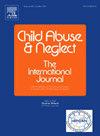Treatments for child neglect: A scoping review
IF 3.4
2区 心理学
Q1 FAMILY STUDIES
引用次数: 0
Abstract
Background
Unlike more active forms of abuse, child neglect involves the omission of care. It is one of the most prevalent forms of child maltreatment, yet there is no consensus on its definition. Because of its high prevalence and severe consequences, there is a need for evidence-based interventions.
Objective
Despite this urgency, an up-to-date synthesis of research on the effectiveness of treatments for children who experienced neglect is lacking.
Method
This scoping review mapped the scope, nature, and characteristics of studies on the treatment of children who experienced neglect published in the past decade, by using methodology for scoping reviews by Arksey and O'Malley (2005).
Results
A total of 31 studies met the inclusion criteria. We extracted information on publication year, study design, participant characteristics, type of maltreatment, measurement instruments, and treatment characteristics. Most studies employed experimental designs and originated from Western countries. Ethnic minority representation was generally low. The majority of studies included populations where neglect co-occurred with other forms of maltreatment. Among the interventions studied, the SafeCare Program and Multisystemic Therapy (MST-CAN) were most common. Treatments typically targeted families or parents, focusing on skills training and relationship enhancement.
Conclusions
Research into the effectiveness of treatments for neglected children remains scarce and displays many gaps. There is a limited range of interventions for children who experienced neglect, with limited trauma and child focused interventions available. Furthermore, gaps are prominent in external validity and generalizability, including underrepresentation of ethnic minority populations. Future studies should incorporate culturally sensitive recruitment practices for increasing ethnic minority groups and are encouraged to apply intensive, multicomponent interventions.
儿童忽视的治疗:范围审查。
背景:与更主动的虐待形式不同,儿童忽视涉及忽视照顾。这是最普遍的儿童虐待形式之一,但对其定义尚未达成共识。由于其高患病率和严重后果,有必要采取循证干预措施。目的:尽管这一紧迫性,一个最新的综合研究的有效性治疗的儿童经历忽视是缺乏的。方法:通过使用Arksey和O'Malley(2005)的范围评估方法,本范围评估绘制了过去十年中发表的关于遭受忽视的儿童治疗的研究的范围、性质和特征。结果:共有31项研究符合纳入标准。我们提取了出版年份、研究设计、参与者特征、虐待类型、测量工具和治疗特征等信息。大多数研究采用实验设计,起源于西方国家。少数民族的代表性普遍较低。大多数研究包括忽视与其他形式的虐待同时发生的人群。在研究的干预措施中,安全护理计划和多系统治疗(MST-CAN)是最常见的。治疗通常针对家庭或父母,侧重于技能培训和增进关系。结论:对治疗被忽视儿童的有效性的研究仍然很少,并且显示出许多空白。针对遭受忽视的儿童的干预措施范围有限,创伤和以儿童为重点的干预措施也有限。此外,在外部有效性和概括性方面存在明显差距,包括少数民族人口的代表性不足。今后的研究应纳入对日益增加的少数民族群体具有文化敏感性的招聘做法,并鼓励采用密集的多成分干预措施。
本文章由计算机程序翻译,如有差异,请以英文原文为准。
求助全文
约1分钟内获得全文
求助全文
来源期刊

Child Abuse & Neglect
Multiple-
CiteScore
7.40
自引率
10.40%
发文量
397
期刊介绍:
Official Publication of the International Society for Prevention of Child Abuse and Neglect. Child Abuse & Neglect The International Journal, provides an international, multidisciplinary forum on all aspects of child abuse and neglect, with special emphasis on prevention and treatment; the scope extends further to all those aspects of life which either favor or hinder child development. While contributions will primarily be from the fields of psychology, psychiatry, social work, medicine, nursing, law enforcement, legislature, education, and anthropology, the Journal encourages the concerned lay individual and child-oriented advocate organizations to contribute.
 求助内容:
求助内容: 应助结果提醒方式:
应助结果提醒方式:


